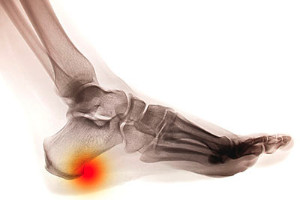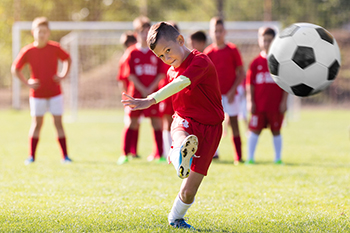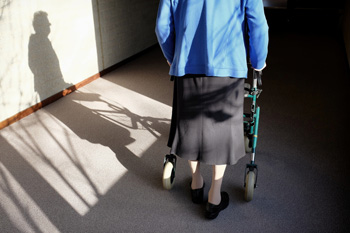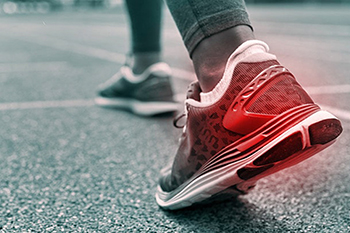Items filtered by date: November 2022
Can Heel Spurs Be Prevented?

Many people have heel pain and show no other symptoms. This can indicate a heel spur has developed, and treatment is often sought for relief. A heel spur is defined as a bony growth that gradually forms on the bottom of the heel, and can come from excessive pressure the heels endure from being overweight, or if the plantar fascia becomes damaged. Wearing shoes that do not fit correctly may cause a heel spur to develop, in addition to having an abnormal foot structure. There are specific groups of people who may be prone to developing a heel spur. These can include runners, elderly people, diabetic patients, or people who have frequent gout attacks. People who have pain with a heel spur often notice there is tenderness surrounding the heel, and the affected foot and ankle may become swollen. Additionally, there may be sharp heel pain after rising in the morning. Effective prevention methods may consist of stretching the feet regularly, wearing insoles that can provide support, and maintaining a healthy weight. If you feel you have a heel spur, it is strongly urged that you consult with a podiatrist who can properly treat this condition.
Heel spurs can be incredibly painful and sometimes may make you unable to participate in physical activities. To get medical care for your heel spurs, contact Nrup Tolat, DPM from Atlanta Total Foot & Ankle Care. Our doctor will do everything possible to treat your condition.
Heels Spurs
Heel spurs are formed by calcium deposits on the back of the foot where the heel is. This can also be caused by small fragments of bone breaking off one section of the foot, attaching onto the back of the foot. Heel spurs can also be bone growth on the back of the foot and may grow in the direction of the arch of the foot.
Older individuals usually suffer from heel spurs and pain sometimes intensifies with age. One of the main condition's spurs are related to is plantar fasciitis.
Pain
The pain associated with spurs is often because of weight placed on the feet. When someone is walking, their entire weight is concentrated on the feet. Bone spurs then have the tendency to affect other bones and tissues around the foot. As the pain continues, the feet will become tender and sensitive over time.
Treatments
There are many ways to treat heel spurs. If one is suffering from heel spurs in conjunction with pain, there are several methods for healing. Medication, surgery, and herbal care are some options.
If you have any questions feel free to contact our offices located in Woodstock and Atlanta, GA . We offer the latest in diagnostic and treatment technology to meet your needs.
Why Live with Pain and Numbness in Your Feet?
Causes and Treatment of Sever’s Disease

In the first few years of a child’s life, the bones in their feet develop from soft areas of cartilage, known as growth plates. Once the growth plate fully develops, the bones do not grow any further. The heel bone grows until about the age of 15. A child between the ages of 9 and 15 who is physically active may develop a condition known as Sever’s disease. This is simply an imbalance between the growth of the heel bone and the soft tissue. The result is pain around the heel, which is made worse by running or standing on tiptoes. It is nearly impossible to detect Sever’s disease from an X-ray, but the symptoms usually are enough to make an accurate diagnosis. Relief from Sever’s disease comes from ceasing the activity that caused it and resting the foot. Heel pads and splinting at night can help to reduce the pain. For more information about Sever’s disease, please check with a podiatrist.
Sever's disease often occurs in children and teens. If your child is experiencing foot or ankle pain, see Nrup Tolat, DPM from Atlanta Total Foot & Ankle Care. Our doctor can treat your child’s foot and ankle needs.
Sever’s Disease
Sever’s disease is also known as calcaneal apophysitis, which is a medical condition that causes heel pain I none or both feet. The disease is known to affect children between the ages of 8 and 14.
Sever’s disease occurs when part of the child’s heel known as the growth plate (calcaneal epiphysis) is attached to the Achilles tendon. This area can suffer injury when the muscles and tendons of the growing foot do not keep pace with bone growth. Therefore, the constant pain which one experiences at the back of the heel will make the child unable to put any weight on the heel. The child is then forced to walk on their toes.
Symptoms
Acute pain – Pain associated with Sever’s disease is usually felt in the heel when the child engages in physical activity such as walking, jumping and or running.
Highly active – Children who are very active are among the most susceptible in experiencing Sever’s disease, because of the stress and tension placed on their feet.
If you have any questions, please feel free to contact our offices located in Woodstock and Atlanta, GA . We offer the newest diagnostic and treatment technologies for all your foot and ankle injuries.
How Feet Change With Aging

Foot care is especially important for seniors who are more apt to experience falling and mobility issues than those who are younger. Feet change as one ages. Normal changes that happen to feet with age include thick cartilage and fat pads on the soles becoming thinner, the skin and connective tissue becoming fragile and thin, toenails becoming more brittle and prone to fungal infection, and the ligaments holding bones together stretch making feet wider and flatter. Because it is hard for seniors to lean down and bend over, they often neglect foot care. Health conditions can show up aging feet, such as persistent swelling of legs and feet signifying cardiovascular, lymphatic, or kidney disease. Other challenges are cold feet from poor circulation resulting from heart disease, high blood pressure, or nerve damage from diabetes, and foot bone pain from osteoporosis. Seniors are also at risk for bunions, blisters, ingrown toenails, and hammertoes as well. If you are a senior, it is suggested that you visit a podiatrist who can evaluate your feet and provide guidance on how to best take care of them for the highest degree of comfort.
Proper foot care is something many older adults forget to consider. If you have any concerns about your feet and ankles, contact Nrup Tolat, DPM from Atlanta Total Foot & Ankle Care. Our doctor can provide the care you need to keep you pain-free and on your feet.
The Elderly and Their Feet
As we age we start to notice many changes in our body, but the elder population may not notice them right away. Medical conditions may prevent the elderly to take notice of their foot health right away. Poor vision is a lead contributor to not taking action for the elderly.
Common Conditions
- Neuropathy – can reduce feeling in the feet and can hide many life-threatening medical conditions.
- Reduced flexibility – prevents the ability of proper toenail trimming, and foot cleaning. If left untreated, it may lead to further medical issues.
- Foot sores – amongst the older population can be serious before they are discovered. Some of the problematic conditions they may face are:
- Gouging toenails affecting nearby toe
- Shoes that don’t fit properly
- Pressure sores
- Loss of circulation in legs & feet
- Edema & swelling of feet and ankles
Susceptible Infections
Diabetes and poor circulation can cause general loss of sensitivity over the years, turning a simple cut into a serious issue.
If you have any questions please feel free to contact our offices located in Woodstock and Atlanta, GA . We offer the newest diagnostic and treatment technologies for all your foot and ankle needs.
What Type of Running Shoe Should I Buy?

Wearing the right shoes can make a world of difference while running. There are various styles of running shoes that can confuse even the most seasoned athlete, and it is crucial to know which pair is correct for you. Running shoes are divided into several categories, and the pair that provides the most support are referred to as motion control shoes. This type of shoe has maximum arch support in addition to a high heel drop, which may help overpronation. Another type of shoe is called a stability shoe, and these may be appropriate for runners who have less overpronation. Runners who have no overpronation may feel more comfortable while wearing neutral shoes. These are considered to be lighter in weight, and the majority of the cushioning is found in the heel. People who enjoy running barefoot may choose to wear minimalist shoes, and these provide little or no support. Additionally, road running shoes are designed for those people who like to run on hard surfaces, while running on different types of terrain may call for trail running shoes. If you would like more information about what type of running shoes should be purchased, please consult with a podiatrist who can guide you in the right direction.
You should always make sure your running shoes fit properly in order to avoid injury. For more information, contact Nrup Tolat, DPM from Atlanta Total Foot & Ankle Care. Our doctor can provide the care you need to keep you pain-free and on your feet.
Choosing the Right Running Shoe for Your Foot Type
Improper shoe sizing can cause a myriad of problems for your feet. Shoes that don’t fit you properly can lead to muscular imbalances in your body, which can result in foot, knee, and hip injuries.
Tips for Finding the Right Running Shoe
- Make sure you have a thumb’s width of wiggle room between the end of your longest toe and the front of the shoe.
- There should be little to no slipping at the heel
- Don’t assume your size in one shoe brand will be your size in another
- Do not lace up your shoes too tightly
- Walk around in the store with your new shoes before you buy them
If you have any questions please feel free to contact our our offices located in Woodstock and Atlanta, GA . We offer the newest diagnostic and treatment technologies for all your foot and ankle needs.
Tests Can Be Performed That May Help to Diagnose Poor Circulation

A proper diagnosis for patients who have poor circulation can consist of undergoing a physical examination, which can determine what the pulse and temperature are of the feet. This is often compared to the blood pressure in the arms, and is lower in the feet with existing poor circulation. This is then followed by checking the pulse in the entire leg, including the groin, ankles, and the back of the knees. Many times, physical tests are performed that can consist of the leg-elevation test and the leg-drop test. The first test involves lying on your back with your legs raised, and poor blood flow is evident when the leg becomes pale and painful. This is followed by performing the next test. Poor circulation is indicated when the leg will take longer to turn red while lowering the feet to the floor. This condition can be a serious ailment that often affects the feet. If this applies to you, it is advised that you speak with a podiatrist sooner rather than later who can guide you toward the correct treatment.
While poor circulation itself isn’t a condition; it is a symptom of another underlying health condition you may have. If you have any concerns with poor circulation in your feet contact Nrup Tolat, DPM of Atlanta Total Foot & Ankle Care. Our doctor will treat your foot and ankle needs.
Poor Circulation in the Feet
Peripheral artery disease (PAD) can potentially lead to poor circulation in the lower extremities. PAD is a condition that causes the blood vessels and arteries to narrow. In a linked condition called atherosclerosis, the arteries stiffen up due to a buildup of plaque in the arteries and blood vessels. These two conditions can cause a decrease in the amount of blood that flows to your extremities, therefore resulting in pain.
Symptoms
Some of the most common symptoms of poor circulation are:
- Numbness
- Tingling
- Throbbing or stinging pain in limbs
- Pain
- Muscle Cramps
Treatment for poor circulation often depends on the underlying condition that causes it. Methods for treatment may include insulin for diabetes, special exercise programs, surgery for varicose veins, or compression socks for swollen legs.
As always, see a podiatrist as he or she will assist in finding a regimen that suits you. A podiatrist can also prescribe you any needed medication.
If you have any questions, please feel free to contact our offices located in Woodstock and Atlanta, GA . We offer the newest diagnostic and treatment technologies for all your foot care needs.

